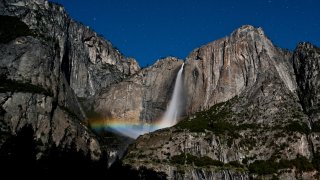
What to Know
- The lunar rainbows are known for appearing the mist created by the waterfalls of Yosemite Valley
- They don't happen every evening, but can occur around the time of a full moon, when the moon's angle is just right
- A cloudless or cloud-lite evening is also important, too
RAINBOWS, on the 17th day of March, can dominate the heart, our whimsies, and the collective imagination. They do, after all, lead to pots of gold, or so fairy tales and folk stories tell us, and seeing the full visual spectrum spanning across a bright blue sky can lift our spirits and fill us with a sense of promise. But what happens when you spy some of those shimmery shades after the sun has bye-bye'd for the day, and the moon is high in the sky? Chances are strong that you're near a source of water, and there's mist in the air, and you're witnessing one of nature's most whimsical phenomena: the lunar rainbow. While that is quite the lovely handle, lunar rainbows are known by a more popular name, a catchy moniker that seems to have enchantingly emerged from a storybook: moonbows. Where, though, can you go to marvel at moonbows, those shimmery, starlit, seemingly unlikely wonders created in partnership with water?
YOSEMITE VALLEY... is a spot synonymous with the after-sunset sights, but timing your visit, and planning accordingly, and, yes, possessing a little luck will play paramount roles. For conditions have to be just so for the moonbow, which can appear in a spray of droplets created by a waterfall, to appear to any nearby admirers. But here's hope: The Yosemite Mariposa County Tourism Bureau shared a lovely, tip-filled list of "Mist Opportunities," when it comes to locating moonbows around Yosemite National Park. You'll want to find a full or full-ish moon (which, as luck would have it, is coinciding with St. Patrick's Day 2022), and our lunar satellite should be at the optimal angle (there are details on that particular position here). The time of year (think spring), the state of the clouds overhead (they're not ideal on a moonbow quest), and other fanciful but scientific factors play a part, including the desirability of a "swirling wind," which, again, seems to hail from a fairy tale.
FOR MORE HANDY TIPS... on this nature-amazing nighttime show, moonbowians should cast a colorful light on this site now.
Get top local stories in Southern California delivered to you every morning. >Sign up for NBC LA's News Headlines newsletter.

